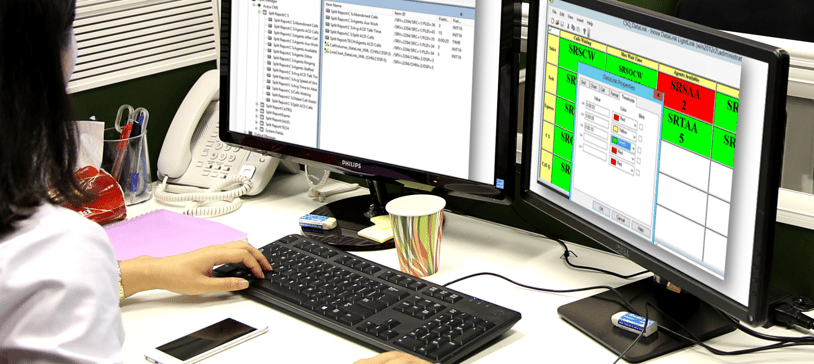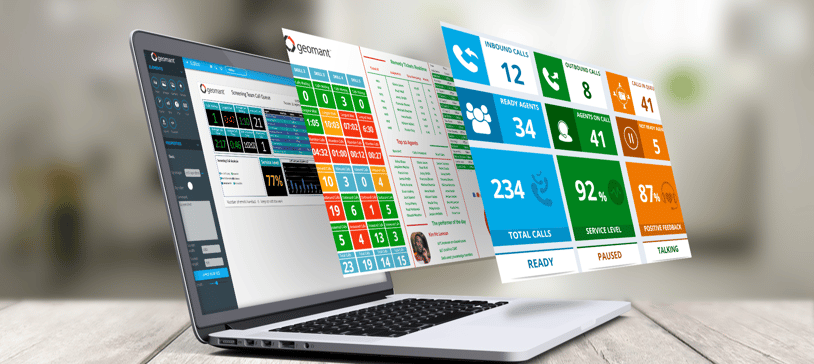19 March 2021
You have decided that it’s time to invest in a contact center wallboard solution.
Maybe you need a better way to engage and motivate agents. Or perhaps supervisors require more visibility over the customer service process. Whatever the reason, you know that investing in wallboard technology is a process that requires careful consideration and planning.
Here’s what you need to know to ensure the project runs smoothly.
Contents:
- Why Wallboards?
- Before You Start: Know Your Goals
- Doing Your Research
- Aligning Internal Stakeholders
- How Much Involvement Does Each Stakeholder Need?
- Engaging a Software Vendor
- Questions to Ask Along the Way
- Getting specific with project expectations
Why Wallboards?
A modern wallboard solution is more than just a digital signage product.
The right system can support contact centers, customer service departments, and help desks in a rapidly evolving environment. With wallboards, managers can track issues in real-time, respond to data trends, provide help to the employees who need it most, and assess team outcomes.
Wallboards also provide your employees with the information required to assess their performance in the context of team outcomes. Through the notifications and graphics of a wallboard, your employees can see whether they’re reaching personal, and company-wide goals.
As the modern team continues to evolve, wallboards have transformed into increasingly intuitive solutions for staff motivation and management.
So, how do choose the right system?
Before You Start: Know Your Goals

The first step in a successful wallboard project is knowing what you want to accomplish.
Wallboards are simple yet effective tools that aggregate data from various sources, and present that information in an easy-to-consume format for your agents. You can use a wallboard to show your team members the average number of calls they’re handling per hour or allow them to track their call resolution time compared to their peers – the possibilities are endless.
Today’s wallboards are highly customizable. Many leading solutions provide access to huge amounts of data, so it’s up to you to determine which KPIs and metrics are most essential to your teams. Knowing what you want to accomplish with your wallboard before you start shopping for a provider will help you to find a vendor with the right functionality and features.
Start with a project overview. Bring any key stakeholders and team leaders together to discuss the aims of your new wallboard strategy. Do you have an existing solution that needs to be updated to address the needs of a remote and hybrid workforce? Are you looking for a solution that can give you more access to data from a wide range of platforms now that you have an omnichannel contact center strategy? Whatever your wallboards purpose, you must be clear on it before you start.
Points to consider include:
- Why are you starting the project? What are your main goals? Perhaps you want to motivate your employees and create alignment between in-office and remote workers. If that’s the case, how can you ensure your wallboards are suitable for both kinds of employees?
- When do you need to begin? When’s the best time to start shopping for a wallboard in your organization? Are you about to switch to a new provider for your reporting and analytics? Do you have a contract with a current software provider?
- How long will the roll out take? Are you going to introduce your entire team to the wallboard technology at once? Do you want to start by testing with a small number of users first? This could be an excellent way to check the efficiency of the wallboard design before using it with all team members.
- Do you have any challenges to overcome? What are your budget constraints? Do you have issues regarding complex analytics tools and multiple platforms that you need to connect together? Do you need to work with a vendor that has specific experience in things like Microsoft Teams contact centers?
- Do you have unique needs? Do you need a vendor that can deliver specific features, like customizable mobile dashboards, or SMS alerting for your remote workers?
Doing Your Research

Traditionally, wallboards were simple LED signs placed on the walls of your contact center or service team office. These days, software makes it easy to display wallboard information on virtually any screen, from a television monitor to a desktop or tablet sitting on your remote employee’s desk.
You can create and customize your wallboards using state-of-the-art software, then share that information with your employees wherever they are. The right wallboard technology even allows for team leaders to create different views for employees based on their role in the business.
Depending on the technology available to your company, you can provide your a with an all-in-one dashboard showcasing critical company metrics and use notifications and alerts to keep everyone informed of real-time updates.
Do your research into the kind of wallboards available and ask yourself:
- Do you need software and hardware? (Software for your wallboard displays, and hardware such as monitors or screens for your in-office wallboards)
- Where does your wallboard technology need to work? Should you be able to send information to remote desktops, mobile devices, and tablets?
- What do your wallboards need to integrate with? Common requirements include Unified Communication systems, CRM (customer relationship management) technology, telephony systems, contact center solutions, and company intranets or newsfeeds.
- What kind of deployment do you need? Are you looking for something to be deployed on-premises, in the public cloud, or over private cloud?
- How much control do you need? Can you adjust your wallboard technology on the fly from anywhere? How quick and easy is it to change the information on your wallboards?
- How much maintenance does your wallboard require? Is a managed wallboard service ideal for reducing the amount of pressure on your internal IT team?
Aligning Internal Stakeholders

When you’re investing in new technology for your team, it’s crucial to get the stakeholders and leaders in your workforce on the same page. Who is going to be involved with this wallboard deployment? Who do you need to address things like remote maintenance, and reporting?
Remember, poor project communication and coordination is responsible for around 80% of project failures. Knowing how you’re going to implement your wallboards, where they’re going to integrate with your existing tools, and how you’re going to measure success is essential.
Ask yourself who is:
- Responsible: Who is involved with choosing your wallboard solution, using it, and implementing it? Who should be responsible for connecting with vendors, and asking questions about the new solution?
- Accountable: Who’s going to be making sure the technology works as it should? Will your IT team be responsible, or will you be using the expert support of a hosted provider?
- Consulted: Who do you need to consult about your wallboards? The supervisors and managers that will be relying on this technology each day may need to have a say.
- Informed: Who else might need to know about what’s going on here? You’ll need to ensure your employees are well-informed about their new technology and know how to use it.
Take your time to discuss the requirements of the project carefully. It’s important that everyone on your team understands the value of this new investment.
How Much Involvement Does Each Stakeholder Need?

The stakeholders and internal players in the team you create for your wallboard investment may include:
- Contact Centre Managers/Supervisors
- Corporate Sourcing
- Facilities
- Telecom
- IT
- Desktop Support
- Network Security
- Operations
Think about how much involvement these people need, and what kind of issues you’ll need to address when you’re searching for the right solution: For instance:
- What kind of metrics do your managers need to see? What are the problems they need to solve?
- What kind of information will agents and IT professionals need to see?
- What format are you going to use for displaying your data?
- Other than call data, is there anything else you need to show in real-time?
- Can you assess the engagement and involvement levels of your staff through your wallboard?
- Do you need to show different content in different areas to match the needs of different stakeholders? For instance, will customer service teams only see information about customer service calls?
Engaging a Software Vendor

With your stakeholders aligned, and a good idea of your goals in mind, it’s time to start looking for a vendor that can deliver the technology you need. A flexible cloud-based wallboard solution will be the most beneficial option for most companies these days.
Some of the must-have features to look for include:
- A supervisor dashboard: A convenient and intuitive dashboard for management teams to use
- Real-time analytics: The ability to track changes in real-time
- Omnichannel performance: Your wallboard should connect activity across all channels
- Agent dashboards: Custom dashboards designed for contact center agents.
- Threshold-based alerting: Alert agents when metrics reach a pre-defined level, for example, alerting agents when call volumes go above x%.
- Multimedia information: A great wallboard will be able to show not just text, but also informative images, videos, and other content too.
Do you want your team to be responsible for deploying and maintaining your wallboard, or are you going to choose a SaaS solution that’s handled by your vendor?
If you do choose a hosted solution, look for a company that provides a cloud service you can trust, such as the Microsoft Azure cloud. Discuss your options and unique challenges with your vendor to make sure that you’re investing in the right solution.
Questions to Ask Along the Way

As you find and implement your wallboard solution, remember to answer the following questions:
- What specific problems are we solving with the wallboard solution?
- What direct value does each feature in this wallboard solution have to offer?
- What frustrations do we hear from contact center agents the most?
- How well do our systems communicate and integrate?
- How scalable and customizable does the wallboard need to be?
- What kind of performance and customer data do we need to capture?
- How will we display the information that we capture?
- Will we store any data and how can we keep it secure?
- How will we decide when to send alerts and notifications through wallboards?
- How will we track the success of our wallboard?
Getting specific with project expectations

The more specific you are with your expectations regarding your wallboard technology, the easier it will be to ensure that you’re making a positive investment. A wallboard can be a powerful tool for your company, but it works best when you know how to leverage the data available to your team in a way that cultivates better performance and engagement.
Use your goals to determine the kind of expectations that you need your wallboard solution provider to adhere to. What are your expectations when it comes to things like customization and control? How can you adapt your wallboards over time to suit the changing needs of your team? What kind of strategies can you use to track the success of your wallboard initiatives?
Remember to have an idea in place of how you’re going to assess the outcomes of your wallboard technology. Measuring metrics like customer satisfaction and employee engagement levels can give you an insight into the impact your wallboards are really having.
Create a list of your expectations that covers:
- What you absolutely must-have (access to certain metrics and features)
- What would be nice to have to make the service better (custom colors for instance)
- What kind of challenges you need your vendor to help you overcome?
- What sort of results you want to see – and within which timeframe
- How you expect to get assistance if anything goes wrong
It’s also worth thinking about whether your wallboard solution provider can give you the support you need for future wallboard technology too. What kind of investments are they making in things like artificial intelligence and IoT? How can they ensure that you’re prepared to serve a hybrid and remote workforce, as well as an in-office team?
Wallboards are a valuable addition to your strategy for employee engagement, team management, and business productivity. However, just like any investment in your technology stack, it’s important to have a plan for how you’re going to implement and leverage your wallboards.
Follow a strategy that empowers your team, supports your managers, and offers complete visibility, and you’ll pave the way for company growth.
Useful Links